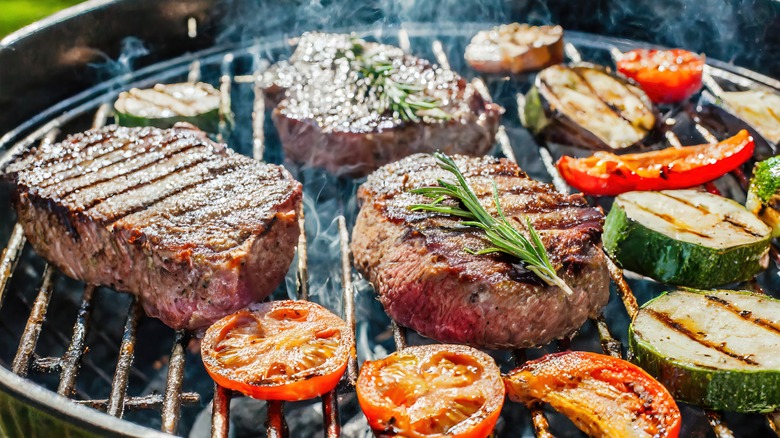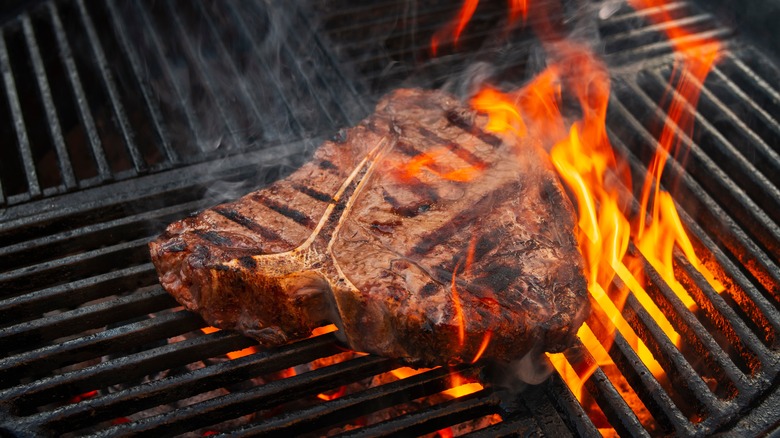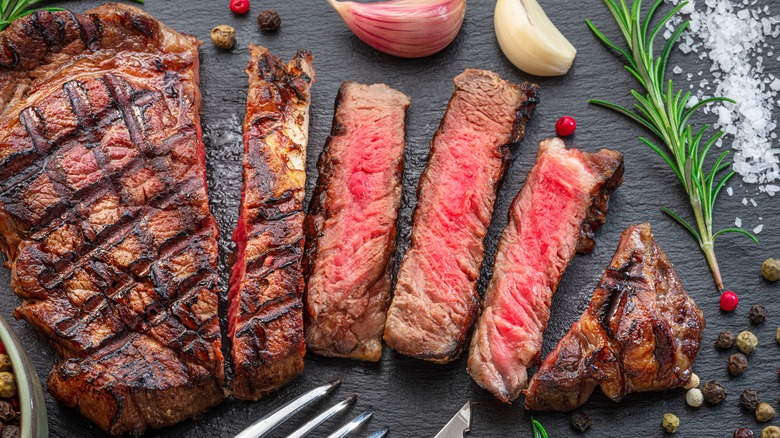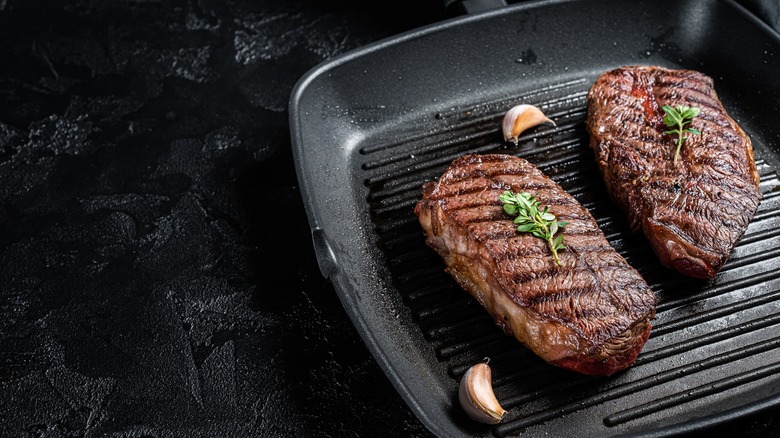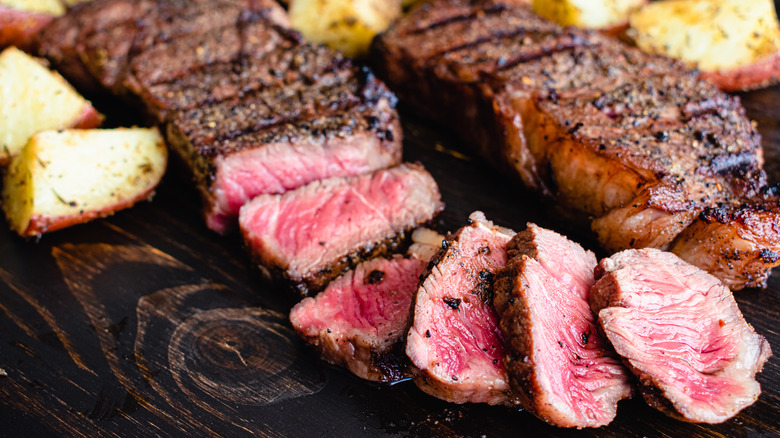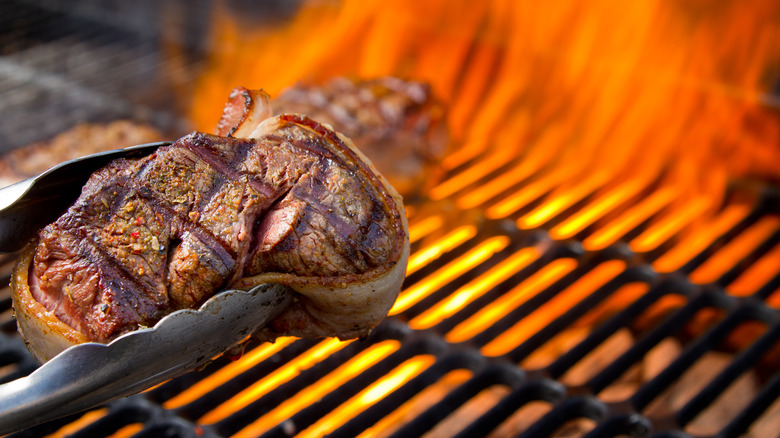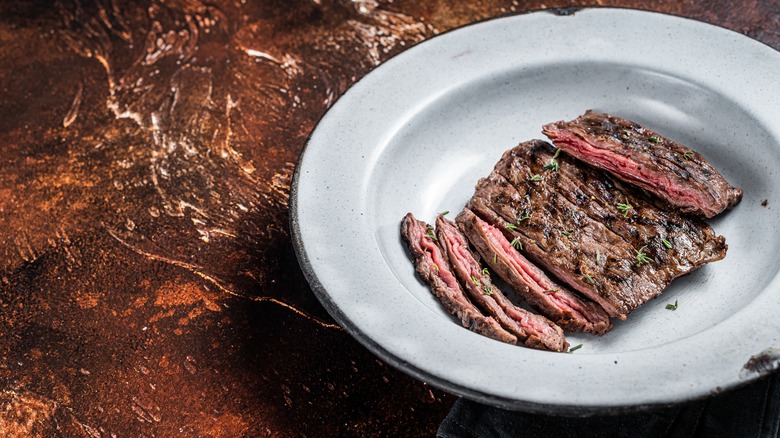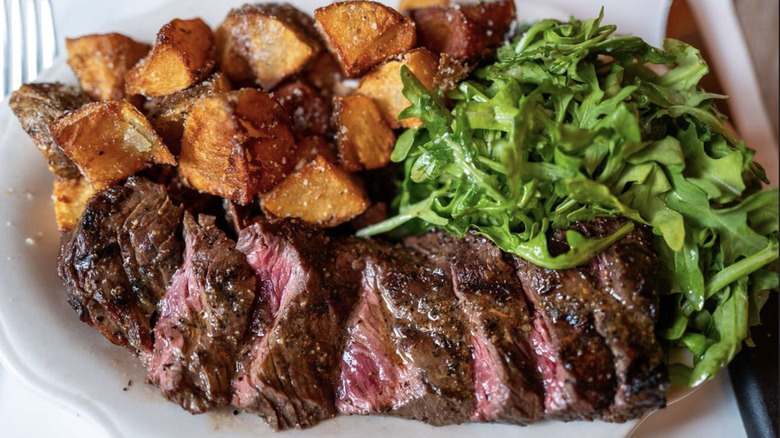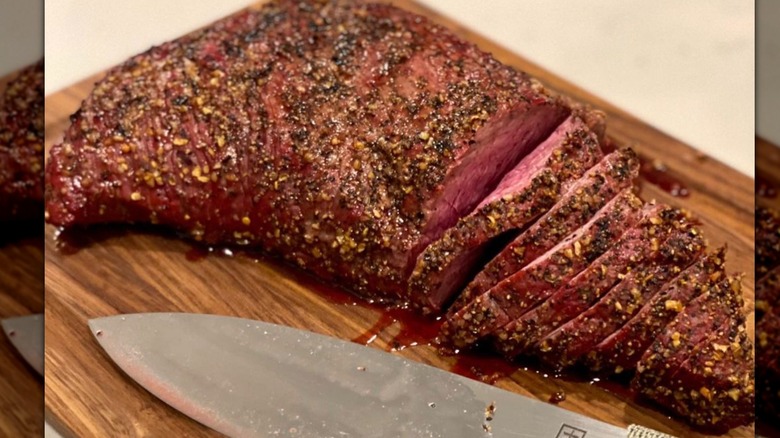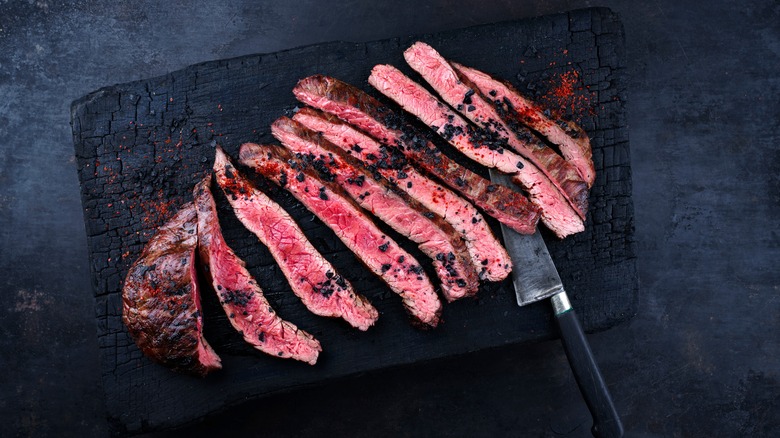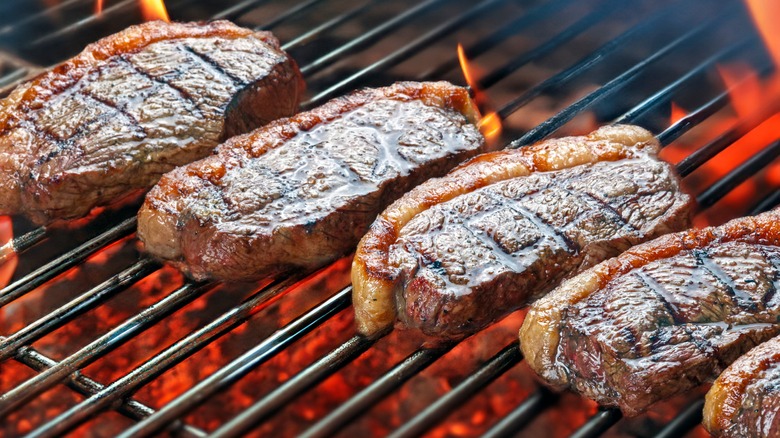The Absolute Best Cuts Of Steak For Juicy Grilling, According To A Grill Master
For a serious carnivore, there are few sights more beautiful than a steak hitting a grill. The robust flavor and juicy texture that a grill imparts on steak is nothing short of magic. But with all the different cuts of meat available at the butcher, it's not always obvious which ones are best suited for grilling. Most meat lovers know the difference between a fatty, heavily marbled ribeye and a lean, flavorful hanger steak, but how do these properties play out specifically when meat is cooked on the grill?
To get to the bottom of this meaty mystery, I spoke with Evan Lobel, co-owner of Lobel's of New York, a meat purveyor on Manhattan's Upper East Side, and author of several books including "Prime Time Grilling" and "Lobel's Meat Bible." The Lobel family has been in the meat business for six generations, so this man knows how to grill up perfectly seared steaks. "Grilling offers something unique compared to other methods like pan-searing or broiling: that beautiful char and smoky flavor you just can't replicate indoors," Lobel told me.
Porterhouse
A porterhouse steak is not for dainty eaters. It can regularly clock in at about 24 ounces, one of the largest cuts of steak, so it's ideal for sharing. The cut comes from the short loin of the animal — right behind the ribs — and has robust marbling and a big bone that make it ideal for grilling. Synonymous with size, a "porterhouse gives you the best of both worlds — a tender filet on one side and a flavorful strip on the other," said Evan Lobel.
The strip side of the steak has more marbling, so a hot grill sears the outside, giving a beautiful charred crust on the outside while the inside remains juicy. The filet is leaner, but still very tender, and also does well with the high heat of a sizzling grill. The bone between these two cuts of meat doesn't provide flavor, as many people think, but it does make the steak juicer. Because the bone doesn't heat as quickly as the rest of the steak, the meat near it cooks more slowly, giving you a more succulent product.
Ribeye
Steak lovers far and wide know ribeye as a particularly tender cut of meat. "Ribeye stands out because of its marbling, which renders during grilling, keeping the steak juicy and flavorful," Evan Lobel told me. Marbling is intramuscular fat and it looks like little white streaks and flecks found within the muscle portion of a cut of meat. It's not to be confused with extramuscular fat, found on the outside of a cut of meat, which tends to be chewy, hard to swallow, and is trimmed off the meat.
As Evan Lobel put it: "Marbling is crucial for juiciness. As the steak cooks, the fat melts and bastes the meat from the inside, adding moisture and flavor." Ribeye comes from a part of the cow near the ribs that isn't exercised a whole lot, which gives it a chance to build up more marbling. When a ribeye hits a sizzling hot grill, the fat and protein in the meat react with heat for produce a charred crust with a distinct umami flavor. Meanwhile, the fat within the meat melts slowly, coating the muscle fibers for a super juicy steak. The only downside to grilling ribeye is the price. Because this cut is so prized for its succulent flavor, it's generally a little more expensive.
Flat iron steak
If you're grilling steak on a budget, flat iron may be the cut you're looking for. "Flat iron doesn't have the name recognition of more popular cuts, leading to misconceptions about its quality," Evan Lobel said. Flat iron steak has a high degree of marbling, making it super tender, and it has a rich, meaty flavor.
"Since it comes from the chuck, known for tougher meat, people assume it isn't tender enough for grilling," Lobel explained. Chuck is the most popular cut of meat for ground beef because it has a bold, beefy flavor and a lot of connective tissue, which doesn't matter too much when the cut is all ground up. But flat iron isn't like the rest of the chuck. "When properly prepared, flat iron is quite tender," he said.
It also holds up well with a marinade, making it a great choice for flavorful steak dishes like beef tacos. This cut is thinner than most, so when it hits a hot grill, it'll typically need less time than thicker cuts and you don't want to cook it too far beyond medium.
New York strip
Let's hear it for New York (strip). This super tender, perfectly fatty cut of meat is one of the most popular cuts of steak for the grill. Sometimes known as club steak or strip loin steak, this cut is from the short loin, a muscle that doesn't get a whole lot of exercise, making it stay super tender. New York strip has a high degree of marbling and, as Evan Lobel put it, "more marbling generally means more flavor."
Because New York strip is so naturally tender and flavorful, you don't need to add a whole lot of ingredients to grill yourself up a supremely delicious dinner. Coarse salt, black pepper, and a bit of olive oil is all you need. New York strips generally come sliced pretty thick, about 1.5 to 2 inches, and they're best enjoyed medium or medium-rare. Having the grill piping hot when you lay your steak on it ensures that you'll get the outside nice and charred without overcooking the inside. For more evenly cooked steaks, especially thicker ones like the New York strip, temper them by leaving them outside the refrigerator or for a little while before they hit the grill.
Filet mignon
Go ahead, say it: filet mignon. These gentle French words are the epitome of steakhouse chic, describing a cut of meat that, despite lacking the fatty texture of some other juicy cuts, still falls apart in your mouth. "Filet mignon is leaner but famously tender, and while it lacks marbling, its delicate texture makes it perfect for the grill," Evan Lobel explained. This steak is cut from the end of the tenderloin, a muscle that doesn't get worked out throughout the life of the cow, which keeps it super tender (hence the word "tenderloin").
The key to grilling a delicious filet mignon is not overcooking it. This cut is best eaten rare to medium rare so that the internal temperature of the meat doesn't get so high that it toughens up. Still, you want to get a nice char on the outside to get that signature smoky, umami flavor that comes from the grill. It's best to heat a gas grill up to medium-high or, if you're using a charcoal grill, put the steak directly above the coals.
Many people argue that filet mignon is the best steak at the grocery store, but it's also one of the pricier cuts. Each cow only has two filets, and they're quite small, so you'll be paying a pretty penny for this decadently tender steak.
Skirt steak
Of all the cuts on this list, skirt steak is one of the most misunderstood. This cut is lean and has a lot of connective tissue. While these characteristics may sound less appealing than a tender, fatty ribeye or a melt-in-your-mouth filet mignon, skirt steak very much still has its place. And that place is on the grill.
"Skirt steak is frequently overcooked because many think its leanness requires longer cooking times. In reality, it should be grilled quickly over high heat and sliced against the grain to keep it tender," Evan Lobel told me. So fire up that grill as hot as it goes (some people even cook skirt steak directly on the coals) and keep an eye on it because it's a pretty thin cut and you don't want to overcook it. Skirt steak readily absorbs the flavors from a marinade, so it's the best steak cut to use for classic fajitas and other beef dishes with bold, intense flavors.
It's generally also one of the less expensive cuts at the butcher and because it's super quick to make, it's a great option for a weeknight dinner. Not only is it crucial that you let skirt steak rest after grilling and cut it against the grain, but also try to slice the pieces as thinly as you can to make it as tender as possible.
Hanger steak
Hanger steak may not have the notoriety of some other more famous, expensive cuts. The cut isn't super popular in the United States, but it's a staple in French bistros, prized for its intense, meaty flavor. Despite its lack of popularity, hanger steak "can be juicy when grilled correctly," said Evan Lobel, and it's generally a great option when you're grilling on a budget.
Like skirt steak and flank steak, hanger steak comes from the diaphragm of the cow, but unlike the others, it doesn't see much exercise during the life of the cow, so it has more marbling, meaner its fattier and more tender. It typically comes with an inedible white membrane that runs along the length of the cut that needs to be removed. Grilling is an ideal method for cooking hanger steak because it tastes best when it's seared for a short time at a high temperature. It also lends itself to marinades and dry rubs, so it's a good cut if you're looking to get adventurous with flavors. Hanger steak isn't usually available in the pre-cut meat section of the grocery store and you may have to request it from your butcher.
Tri-tip
In the category of lean, juicy, and great on the grill, tri-tip takes the gold. This lesser-known cut is named after its triangular shape and has a reasonable amount of intramuscular fat, keeping it nice and tender. "For those seeking leaner options, tri-tip can still deliver juicy results. While it doesn't have the same marbling as ribeye, grilling it to medium-rare and letting it rest will help retain its juices," explained Evan Lobel.
Tri-tip is great for grilling because you want to cook it hot and fast, searing the outside to get a light char while keeping the inside moist and flavorful. In general, "leaner cuts ... do well with direct heat throughout as long as you monitor them carefully," Lobel said.
It's also important to slice this cut against the grain to keep it from getting stringy and difficult to chew. On its own, tri-tip has a rich, beefy flavor and you can grill it with just salt and pepper. If you want a more complex flavor profile, try marinating it for a few hours before you fire up the grill or using a dry rub. Tri-tip isn't the easiest cut to find, so you'll have to talk to your butcher about getting your hands on some.
Flank steak
Unlike most prized cuts of meat, which come from the loin and rib of the cow, flank steak comes from the bottom of the animal near the abdomen. Cuts from that area aren't as popular because they see a lot more use during the life of the animal, which makes them tougher and not as tender. It's a super lean cut, but what it lacks in fat it makes up for with a powerful meaty flavor that holds up to rubs and marinades.
The grill is perfect for cooking flank steak because it lends the meat a deep, umami char. "The high heat of the grill sears the outside, locking in juices while still achieving a perfect crust," Evan Lobel says. Letting flank steak rest after it comes of the grill is crucial to ensure that the juices from the steak end up inside the meat and not all over the plate. Because it's not as easy to cook, flank steak is among the cheaper cuts of steak available at the grocery store.
Top sirloin
If you've ever eaten at a Brazilian steakhouse, chances are you've eaten top sirloin. This cut, known as "picanha" in Portuguese, is famous for the thick strip of fat that curls around one side, bathing the meat in its rich, tasty juices. While this cut isn't very sought-after in the U.S., top sirloin is traditionally grilled on skewers in Southern Brazil, where it's one of the most popular cuts.
Top sirloin sometimes gets a bad reputation for being tough and chewy, but it's grilled just right, it has a rich, beefy flavor. While it's a matter of preference, top sirloin is best enjoyed medium rare so that it doesn't get too tough and overcooked. "To ensure juiciness, it's essential to use a meat thermometer instead of cutting into the steak repeatedly," Evan Lobel said. And not all sirloins were created equal. Top sirloin has more marbling and fat than sirloin, so don't get these two similar cuts confused.
